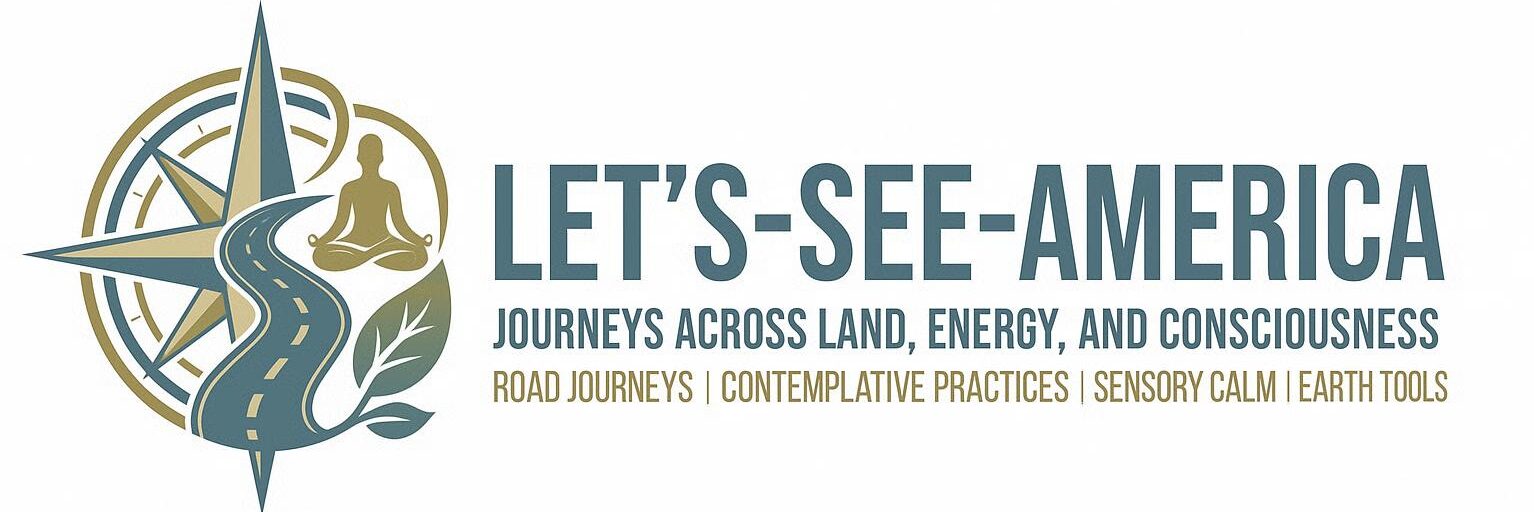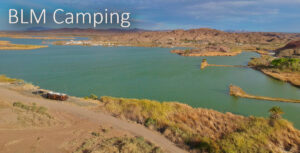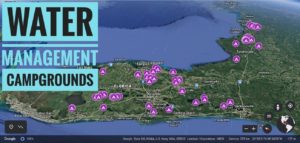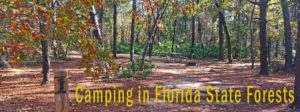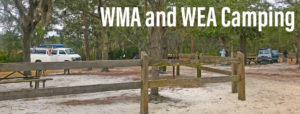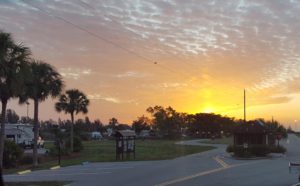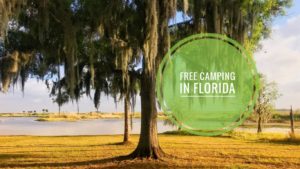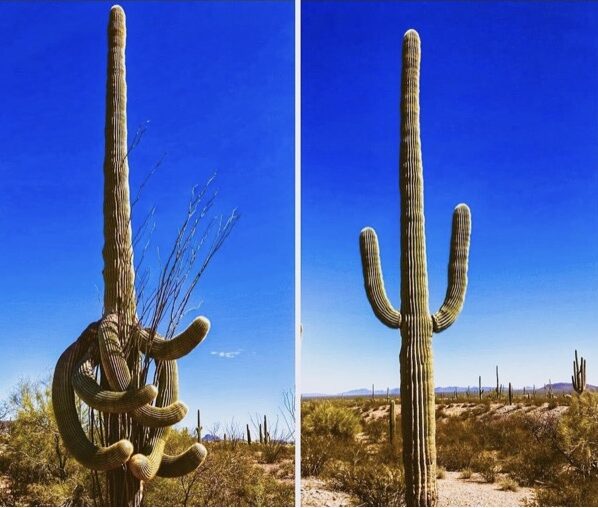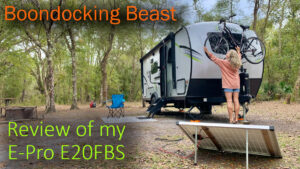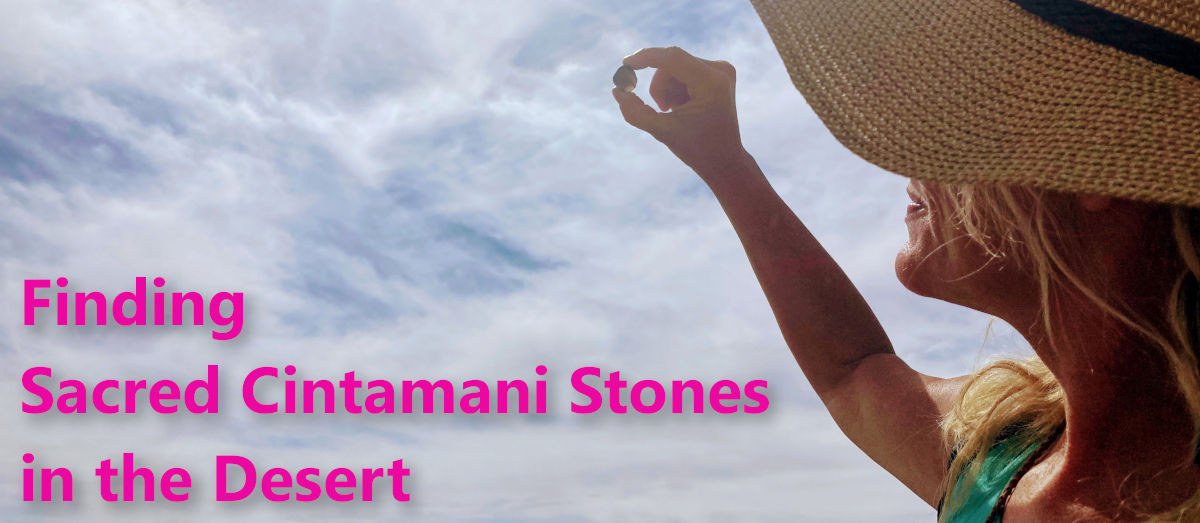Updated for 2024
YES, free camping in Florida is possible in Florida if you want to boondock or dry camp!
At first glance, finding free camping sites in Florida is an easy process. Simply go to one of several websites or camping phone apps and browse an area of interest. But that’s when things get interesting because the State of Florida is host to a variety of camping possibilities and many ways to book a site!
In this article, I discuss the overall management or organization of public camping (free or not) in Florida. It is important to understand this Organization Chart because ultimately you are required to have a solid understanding of the rules and regulations of each wildlife/outdoor department or branch of the State of Florida.
Free versus Cheap Camping
Free camping is available in Florida but with strings attached! I will get into the details of this in future articles but for now, just be aware there are different procedures and rules in place when camping for free on different lands.
For example, some free sites require online booking. Others are available on a first-come-first-serve basis, meaning you can just show up. Most have stay limits (14 days usually). Some free sites are closed in hunting season or other times of the year.
Unfortunately, the most popular free camping locations in Florida are often fully occupied in winter when snowbirds flock to the area. At times you may have to opt for a fee-based site. For this reason, I include cheap campgrounds and sites in my articles. How much is CHEAP you wonder?
- $1 – $10 per site per night – CHEAP camping in my opinion.
- $11 -$25 per night – AFFORDABLE camping.
- $26 plus per night is generally beyond my budget except for special occasions. These campgrounds are mostly in State Parks and a lack of privacy can be an issue despite the high rates. It is a shame that some Florida State Park campgrounds are poorly planned and overpriced.
BLM (Bureau of Land Management) in Florida
It irks me when folks talk about free BLM camping in Florida because BLM Camping does not exist in Florida! BLM is huge out west but not so in the East.
Please read my article about BLM but let’s stop using the term “BLM Camping in Florida”.
Overnight Parking versus Boondocking versus Dispersed Camping versus Dry Camping
According to Webster, the boondocks is a remote, thinly settled rural area. Boondocking, therefore, means camping in a remote, thinly settled rural area.
Boondocking
In my writings, boondocking covers all types of overnight stays (free or not) as long as it’s away from established campgrounds and other people. My definition is this – if you are out there camping all alone and can walk around naked without concerns, you are boondocking! If you are alone but afraid someone may see you naked, you are probably dry camping or something, but you are not boondocking!
Examples of boondocking. Just remain respectful and do not walk around naked even if you can!
- Hipcamps where you are isolated on someone’s property. Not free. You may or may not have water/power/sewer.
- Deep inside a National Forest or on BLM land where and when dispersed camping is allowed. Possibly free. You will most certainly not have water/power/sewer.
- A Harvest Host site where you are isolated. Not completely free. You may or may not have water/power/sewer.
Nowadays, true a boondocking experience is becoming harder to find. Out west, more and more BLM or National Forest areas require camping in designated numbered sites only. These may be shared areas such as the “camping pods” near Sedona in Coconino NF, or dispersed numbered sites west of Zion NP on BLM land. This is not boondocking.
In Florida, one can experience some boondocking in the National Forests but certainly not during “general gun” hunting season. Some boondocking sites are available in the Florida Water Management Districts and Wildlife Management Areas but there are many limitations and block-out dates in hunting season.
Dispersed Camping
Federal Agencies prefer the term “dispersed camping” rather than boondocking or dry camping. Generally, this means no services; such as trash removal, and little or no facilities; such as tables and fire pits. Some popular dispersed camping areas may have toilets of some kind – either seasonal or permanent.
Most National Forests have designated “dispersed camping” areas because rangers do not want folks camping all over the place. Overcrowding near popular tourist destinations is a problem and many areas are changing to “numbered” sites – meaning you are allowed to camp in designated sites only. In most other places you are expected to camp where you see existing fire rings or traces of previous usage – the authorities do not want you to “create” new sites or destroy the vegetation by driving off-road.
If you are lucky enough to find an approved remote spot to camp in a designated dispersed area, then congratulations! You are probably boondocking!
More often than not, however, you will camp close to others. In Florida, dispersed camping is allowed on some (not all) public land and during certain times of the year. I discuss this in other articles but hunting season (“general gun” from early December to early March) is not the best time to disperse camp! In most areas, you are then required to utilize designated campgrounds (often called “hunt camps”).
Dry Camping
When you have no hookups to water, power, or sewer, you are Dry Camping!
It can be challenging, especially in the heat or cold but it is often the most rewarding style of camping. You can dry camp in established campgrounds surrounded by campers or the wild (boondocking) as described above.
How about a Walmart parking lot, a truck stop, a rest stop, or a friend’s driveway? These are short-term (overnight) stays and you generally do not set up camp. At times you must park stealthily to avoid law enforcement officials! This is not boondocking and it is not dry camping.
Free camping in Florida requires a dry camping setup – you have to be self-efficient and self-contained! Water and even the occasional toilet and/or dump station are available at a few free campsites but you cannot depend on it because these may be locked for some reason or another.
Organization of Public Camping in Florida
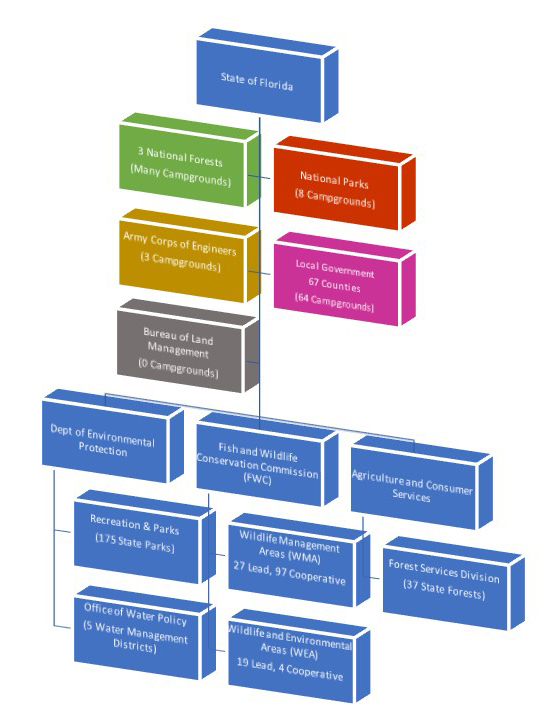
The State of Florida has 3 departments that are of great interest to outdoor enthusiasts. These are marked in blue in the chart above. I will discuss them in more detail in upcoming articles:
- Department of Environmental Protection
- Fish and Wildlife Conservation Commission (FWC)
- Agriculture and Consumer Services
The State of Florida also has stewardship of the lands of 4 national organizations (most of these are well-known and very popular destinations) and dotted-line connections to local county and city governments:
- National Forests
- National Parks
- Army Corps of Engineers
- Bureau of Land Management
- City and County Parks in Florida
Looking at the chart above, there are many “owners” of public camping lands in Florida with many different booking procedures and rules. As stated earlier – in upcoming articles I will explain them all!
To prepare for my future articles, please study my map below.
- The campgrounds or sites of each Department or Division are shown in different colors. Click on the Table of Contents icon (top-left) to see the Index.
- Nightly rates are provided in most cases but this is a work-in-progress! I show both FREE and FEE-BASED campgrounds.
- If you find a missing campground please let me know!
- Only campgrounds accessible by vehicles are shown. Walk-in sites are not shown unless next to a parking area.
- RECOMMENDED – To open a FULL-SCREEN version of the map, simply click on the square in the top right.
Free or Cheap Camping Map of Florida
This map shows each of the campgrounds or areas, grouped by color. For example, State Park Campgrounds (fee required) are shown in Orange, and National Park Campgrounds (fee required) are shown in Red.
In Part 2, I write about BLM and its presence (or lack thereof) in Florida!
